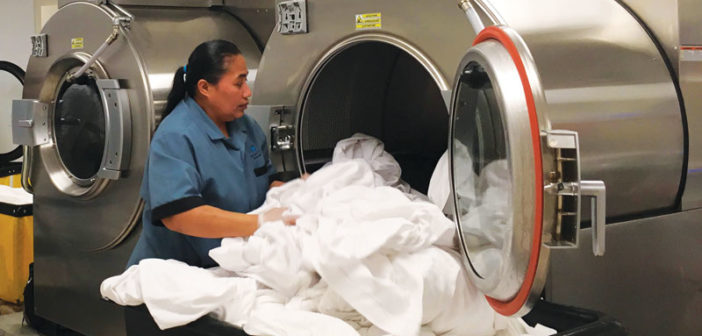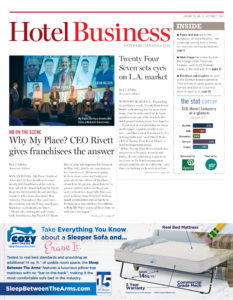NATIONAL REPORT—To repair, or not to repair—that’s the question commonly asked when laundry equipment fails at a property. A general manager’s first instinct may be to request for the appliance to be serviced; however, there’s another option, particularly with older equipment—and that’s replacement, which could be avoided with proper maintenance.
“The longevity of equipment starts with a preventative maintenance program,” said Rick Murphy, sales manager for Maytag Commercial Laundry. “Incorporating equipment care—cleaning exterior and interior surfaces regularly, emptying dryer lint compartments, cleaning dryer exhaust ducts, etc.—can have a significant impact on how well and long machines run.”
Aside from mechanical issues, laundry equipment presents properties with the following challenges, which, more often than not, impact operating costs and quality in hotel laundries: over-drying, loads sitting in equipment too long, under loading, incorrect cycles being selected and other missteps.
“No matter the age of the equipment, it’s important to properly train staff to ensure all employees have the knowledge to use laundry equipment appropriately,” Murphy said. “Having a regular maintenance program in place, such as cleaning the front of machines, as well as the floors and walls surrounding dryers, can help reduce dust and lint build up, and helps to optimize the life of the equipment.”
Things can still go wrong even when laundry equipment is properly maintained, and the reasons for that vary. “Any issues with equipment can be subjective to the environment, employee training and maintenance plans that are associated with the equipment,” he said. “Communication is key. Laundry personnel, maintenance and management staff should consistently track equipment performance and throughput for indicators of performance issues.” Following this guidance also assists owners and operators with analyzing equipment effectiveness and speeding up laundry operations in hotels.
“Every facility and its needs are different,” he said. “However, it’s important for owners and operators to do their homework to make sure they have the right mix of machines in the facility. For instance, knowing how many hours the equipment will operate daily—in reference to the number of hotel rooms, types of linens laundered, etc.—can help determine where larger or smaller equipment will ensure a smoother, more efficient laundry operation.”
Sometimes, factors outside of the laundry can impact operations. “Say a laundry facility is in a hotel, and that hotel sees an increase in business,” Murphy said. “It is likely the equipment mix will need to be updated, which could mean replacing old equipment to maximize space. Recognizing this change as it’s happening can help facilities manage replacement schedules long term and determine the replacement model.” Investing in new equipment is essential to increasing throughput and labor productivity.
There’s a rule of thumb when it comes to replacement: Don’t perform major repairs on equipment that is 12 years old or older, said Bill Brooks, North American sales manager at Unimac. The exception to the rule is lower-volume laundries, which may get more life from their equipment. More often than not, this can be the best time for properties to chat with a distributor to determine if the ROI on new equipment makes sense to go with an upgrade rather than a repair.
“Costs associated with replacing equipment have several variables,” Murphy explained. “The best plan is to start with what you know. For example, a facility manager or operator needs to know the amount of years equipment operated before needing to be replaced. This can help determine replacement equipment. Be diligent in documenting operations and make sure a preventative maintenance program is in place.”
There’s opportunity for managers to improve operations when laundry equipment reaches the end of its useful life. For example, technology’s always changing. “This is why management should get a fresh look by working with an experienced distributor,” Brooks said. “They can offer ideas on if switching up capacity makes sense, and how new technology, such as laundry management systems, can reduce costs and improve management.” Installing multiple smaller capacity machines versus one large one can also make the most sense, due to the fact that laundry at hotels rarely arrive all at once.
“Technology continues to drive innovation and efficiency in commercial laundry,” Murphy told Hotel Business. “For example, more owners and operators are installing multi-load, high-speed washers with a g-force of at least 200. Higher g-force simply means more water is removed, which helps extra water in the washer instead of the dryer. This allows linens to dry quickly. In general, technology is very important to laundry operations, and it is essential for maintaining consistency, reducing error and maximizing efficiency.”
Another technological advancement aiding hotel laundry operations is the adoption of a laundry management system. “Such systems are the manager’s eyes and ears to ensure quality and that equipment is being operated properly, which also helps to extend the life of this investment,” Brooks said. Upgrading equipment networked to this system can ultimately deliver significant ROI.
“The bottom line is that it’s tough to put a figure on when equipment needs to be replaced, but if your repair costs are increasing and efficiency is dropping, it’s likely a good time to meet with your distributor about the return on upgrading to new equipment,” Brooks said. HB


